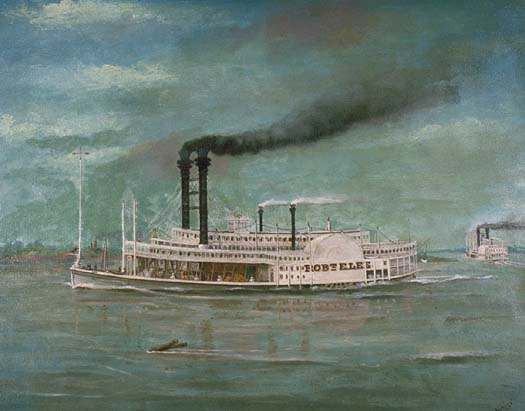 he
Robert
E.
Lee was built in 1866 for the princely sum
of $200,000. Nicknamed
the "Monarch of the Mississippi," this luxurious
side-wheeler is most widely
remembered for winning the famous steamboat race in 1870
against the Natchez
VI, traveling down-river from St. Louis,
Missouri to New Orleans,
Louisiana, a distance of 1,003 nautical miles in a bit
over 90 hours (3
days, 18 hours and 14 minutes). That indicates an
average of about
11 knots, allowing for stops to refuel alongside
pre-arranged barges in
mid-river -- delays which would have been partially
offset by the 'down
hill' current. he
Robert
E.
Lee was built in 1866 for the princely sum
of $200,000. Nicknamed
the "Monarch of the Mississippi," this luxurious
side-wheeler is most widely
remembered for winning the famous steamboat race in 1870
against the Natchez
VI, traveling down-river from St. Louis,
Missouri to New Orleans,
Louisiana, a distance of 1,003 nautical miles in a bit
over 90 hours (3
days, 18 hours and 14 minutes). That indicates an
average of about
11 knots, allowing for stops to refuel alongside
pre-arranged barges in
mid-river -- delays which would have been partially
offset by the 'down
hill' current.
As depicted in this painting by August
Norieri, one might
surmise the vessel to be commanded "All Ahead Full"
making good its fastest
speed on the return trip 'up hill' against the river's
current.
 Fourteen
decades
ago, "carbon footprint" was not considered an
issue. If it
were, 'sustainability' would have taken precedence
over performance. Fourteen
decades
ago, "carbon footprint" was not considered an
issue. If it
were, 'sustainability' would have taken precedence
over performance.
Suppose that the river was flowing
'down-hill' at four knots.
Applying 'green' criteria, the steamboat would have been
commanded to paddle
its way 'up-hill' at what speed?
|
[a] five
knots
[b] six
knots
[c]
seven knots
[d]
eight knots
|
GO TO SOLUTION
PAGE

For solvers
who care, "Steamboat
Hill" is merely a rhyming pun on the title Steamboat
Bill, a 1928 silent film, featuring Buster
Keaton and presently available for viewing in
its entirety at the Internet
Archives.
|

